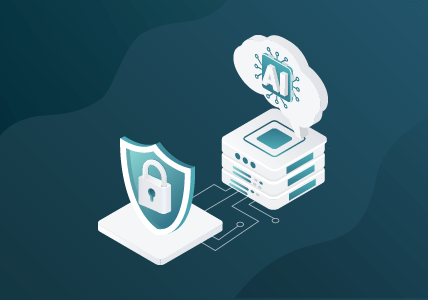Why Deep Observability Is the Foundation of a Robust Zero Trust Network Architecture: A Real-World View
Why Is a Zero Trust Network Architecture Important?
A Zero Trust network architecture (ZTNA) is important for cybersecurity because it provides a more robust and effective approach to protecting networks, systems, and data in today’s evolving threat landscape. Traditional network security models typically rely on a perimeter-based approach: They assume that threats are outside the network; trust is established once inside. However, with the rise of sophisticated cyberattacks, insider threats, and the increasing adoption of cloud services and remote work, this model has proven inadequate.
In this blog, we will look at the key elements of ZTNA, including the critical importance of visibility. We will then look at how the concept of visibility is evolving into deep observability that enables organizations to benefit from comprehensive and actionable insights that support a robust ZTNA-based security posture.
What Are the Benefits of a ZTNA?
In response to the security challenges mentioned above, organizations are increasingly developing networks based on a ZTNA as the basis for their next-generation security architecture. The benefits of this approach include the following:
- Minimizes the attack surface: ZTNA reduces the attack surface by implementing strict access controls and segmentation. It eliminates the assumption of trust and ensures that every user, device, and network resource is continuously authenticated and authorized before granting access. This approach significantly reduces the opportunities for attackers to exploit vulnerabilities.
- Protects against lateral movement: Traditional network architectures often allow unrestricted movement once a user gains initial access, enabling attackers to move laterally across the network and escalate their privileges. In contrast, ZTNA enforces granular access controls, limiting users’ access to only the specific resources required for their tasks. This containment prevents attackers from easily moving within the network.
- Enhances visibility and monitoring: ZTNA provides better visibility into network activity and user behavior. By implementing robust monitoring and logging capabilities, security teams can gain real-time insights into user access patterns, detect anomalies, and respond promptly to potential threats. This proactive monitoring strengthens incident response and reduces the time it takes to detect and contain breaches.
- Supports dynamic environments: With the proliferation of cloud services, remote work, and the Internet of Things (IoT), traditional network perimeters have become more fluid and less defined. ZTNA adapts well to these dynamic environments by shifting the focus from network-centric security to identity-centric security. It ensures that access controls are applied consistently, regardless of the user’s location or the network they are connecting from.
- Emphasizes least privilege: Zero Trust follows the principle of least privilege, providing users with only the minimal access required to perform their tasks. This approach mitigates the risk of accidental or intentional data breaches caused by excessive privileges. Even if a user’s credentials are compromised, the limited access granted under a Zero Trust model can minimize the potential damage.
- Facilitates a comprehensive security framework: ZTNA is not just about network security; it encompasses a comprehensive approach to cybersecurity. It integrates with other security measures such as multifactor authentication, encryption, endpoint security, and behavior analytics to create a comprehensive security framework. This multi-layered approach strengthens defenses and provides better protection against a wide range of threats.
By adopting a ZTNA, organizations can establish a more robust, resilient, and secure environment, effectively mitigating risks and adapting to the changing cybersecurity landscape. ZTNA enables better protection of critical assets, improves incident response capabilities, and enhances overall cybersecurity posture.
Visibility Is a Key Requirement of a ZTNA
Network visibility is crucial for ZTNA because it enables organizations to effectively implement and enforce the principles of Zero Trust. Here’s why network visibility is important for ZTNA:
- Understanding the network environment: Network visibility allows organizations to gain a comprehensive understanding of their network environment, including the devices, applications, users, and data flows within the network. This knowledge is essential for implementing ZTNA effectively, as it helps identify the assets that need protection and determine the appropriate access controls.
- Identifying potential risks and vulnerabilities: Network visibility enables organizations to identify potential risks and vulnerabilities within their network infrastructure. It allows for the detection of misconfigurations, unauthorized devices or applications, abnormal traffic patterns, and other indicators of compromise. This information helps in proactively addressing security weaknesses and mitigating potential threats before they can be exploited by attackers.
- Monitoring user behavior: With network visibility, organizations can monitor user behavior and access patterns in real time. This includes tracking user authentication attempts, access requests, and resource usage. By analyzing this information, security teams can identify any suspicious or anomalous activities, such as unauthorized access attempts, lateral movement, or data exfiltration, and take immediate action to prevent or mitigate potential threats.
- Enforcing access controls: ZTNA relies on granular access controls and policies to ensure that users and devices have the appropriate permissions to access specific resources. Network visibility allows organizations to monitor and enforce these access controls effectively. By understanding the network traffic and user interactions, organizations can verify that access permissions are aligned with the Zero Trust principles, such as the principle of least privilege, and adjust as needed.
- East-West (lateral) traffic visibility: Containing lateral movement is important. In a traditional network architecture, once an attacker gains access to the network, they can move laterally across the network and escalate their privileges. East-West traffic refers to the communication between devices and resources within the network. With visibility into East-West traffic, organizations can detect and monitor the movement of data and users within the network. This visibility helps contain lateral movement and prevent attackers from easily spreading throughout the network.
- Enhancing incident response capabilities: Network visibility plays a critical role in incident response. When a security incident occurs, such as a breach or suspicious activity, organizations need to investigate and respond quickly. Network visibility provides the necessary data and context to understand the scope and impact of an incident, enabling security teams to isolate affected systems, contain the breach, and implement remediation measures effectively.
- Meeting compliance requirements: Many industries have specific compliance requirements that organizations must adhere to, such as HIPAA for healthcare or PCI DSS for payment card processing. Network visibility helps organizations demonstrate compliance by providing visibility into network activities, access controls, and user behavior. It assists in monitoring and auditing network activities to ensure compliance with regulatory standards and promptly identify violations.
Network visibility is essential for successful implementation and enforcement ofZTNA. It enables organizations to understand their network environment, identify vulnerabilities, monitor user behavior, enforce access controls, enhance incident response capabilities, and meet compliance requirements. By leveraging network visibility, organizations can strengthen their security posture and effectively protect their critical assets in the Zero Trust model.
Visibility Is a Critical Component in ZTNA Security Standards and Frameworks
Most ZTNA standards and frameworks identify the need for network visibility, including:
- NIST Special Publication 800-207, Zero Trust architecture: This standard defines network visibility as an essential component of Zero Trust, stating that “network and system activity logs” should be aggregated to provide real-time feedback on the security posture of enterprise information systems.
- ISO/IEC 27033-2, Information security management systems – Network security: This standard requires organizations to “monitor and analyze network traffic to identify and respond to security incidents.”
- PCI DSS (Payment Card Industry Data Security Standard): This standard requires organizations to “monitor and analyze network traffic to identify and respond to security incidents.”
- NIST Special Publication 800-53, Recommended Security Controls for Federal Information Systems and Organizations: This standard includes a number of controls that require network visibility, such as “monitoring network traffic for unauthorized activity” and “monitoring network traffic for known malicious activity.”
- CIS Controls, 20 Critical Security Controls for Effective Cyber Defense: This list includes a number of controls that require network visibility, such as “implement boundary protection” and “monitor all traffic entering and leaving the network.”
Deep Observability: The Next Evolution of ZTNA Visibility
The Gigamon Deep Observability Pipeline takes the concept of network visibility to the next level by augmenting basic visibility with actionable insights developed from a deep analysis of network traffic. Here’s how the Gigamon Deep Observability Pipeline supports ZTNA:
- Enhanced network visibility: The Gigamon Deep Observability Pipeline captures and analyzes network traffic at a granular level, allowing organizations to gain deep visibility into network activities. This visibility extends across all network layers, including East-West traffic within the network. By capturing and inspecting network packets, deep observability provides organizations with detailed insights into network traffic patterns, user behavior, and application interactions. This information is essential for effectively implementing and enforcing the principles of ZTNA.
- Detection of anomalous behavior: The Gigamon Deep Observability Pipeline employs advanced analytics and machine learning algorithms to detect anomalous behavior within the network. It can identify patterns indicative of potential security threats, such as unauthorized access attempts, data exfiltration, lateral movement, or unusual communication between resources. By continuously monitoring network traffic and analyzing it in real time, the Gigamon Deep Observability Pipeline can alert security teams to potential security incidents and help them respond promptly.
- Improved incident response and threat hunting: When a security incident occurs, the Gigamon Deep Observability Pipeline provides valuable data for incident response and threat-hunting activities. The detailed visibility into network traffic helps security teams investigate the root cause of the incident, understand its scope and impact, and determine necessary remediation measures. Deep observability allows security analysts to perform retrospective analysis, conduct threat-hunting exercises, and identify indicators of compromise (IOCs) to proactively detect and prevent future attacks.
- Validation of access controls and policies: ZTNA relies on access controls and policies to enforce the principle of least privilege and limit access to resources. The Gigamon Deep Observability Pipeline helps organizations validate the effectiveness of these access controls and policies. By monitoring network traffic, it can verify if access is granted based on the established policies, detect any deviations or misconfigurations, and ensure that access permissions are aligned with ZTNA principles. This validation helps organizations maintain a strong security posture and prevent unauthorized access.
- Compliance and regulatory requirements: The Gigamon Deep Observability Pipeline supports organizations in meeting compliance and regulatory requirements. Many industry regulations and standards mandate network monitoring and the ability to provide detailed visibility into network traffic. The Gigamon Deep Observability Pipeline assists in fulfilling these requirements by capturing and retaining network packet data, enabling organizations to demonstrate compliance during audits and regulatory inspections.
- Network performance optimization: The Gigamon Deep Observability Pipeline provides insights into network performance, allowing organizations to optimize their network infrastructure. By analyzing network traffic patterns and identifying bottlenecks or inefficiencies, organizations can make informed decisions to enhance network performance and user experience without compromising security.
How the Gigamon Deep Observability Pipeline Enhances Your ZTNA
In summary, the Gigamon Deep Observability Pipeline helps ZTNA by providing enhanced network visibility, detecting anomalous behavior, validating access controls and policies, and meeting compliance requirements. It strengthens the security posture of ZTNA implementations by providing comprehensive and actionable insights into network traffic, helping organizations mitigate risks and effectively enforce the principles of Zero Trust.
Featured Webinars
Hear from our experts on the latest trends and best practices to optimize your network visibility and analysis.

CONTINUE THE DISCUSSION
People are talking about this in the Gigamon Community’s Security group.
Share your thoughts today








